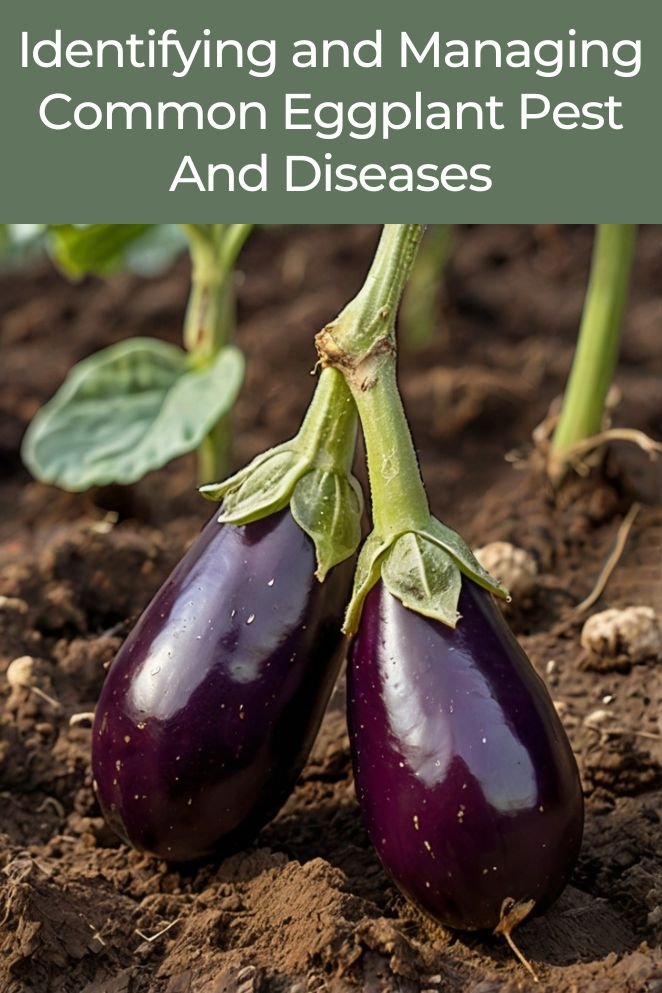
Eggplants, also known as aubergines, are a popular crop in many home gardens.
Their glossy, purple fruits are a favorite in cuisines worldwide but growing them can come with challenges.
Like any crop, eggplants are susceptible to a variety of pests and diseases.
To ensure a bountiful harvest, it’s essential to understand these threats and know how to prevent them.
Common Pests
Eggplants are prone to several pests that can damage the plant, reduce yield, and even kill the plant if not managed properly.
Here are some of the most common pests:
Aphids
Aphids are small, soft-bodied insects, usually green or black, often hiding on the underside of leaves.
Aphids feed by sucking the sap from plants, which causes leaves to curl, stunts growth, and lowers the plant’s yield.
Additionally, they produce honeydew, a sticky substance that can lead to the growth of sooty mold.
To manage aphids, you can introduce beneficial insects like ladybugs, apply insecticidal soaps, or use neem oil as a natural remedy.
Flea beetles
Flea beetles are tiny, dark beetles known for their flea-like jumping when disturbed.
They cause damage by chewing small holes in leaves, which gives them a “shot-hole” look.
If the infestation is severe, it can hinder the plant’s growth.
To protect young plants, consider using row covers, applying insecticides such as spinosad, or spreading diatomaceous earth around the plants.
Spider mites
Spider mites are very small pests, often red or yellow, that resemble tiny spiders.
They’re hard to spot without close inspection.
These mites feed on plant sap, which results in tiny white or yellow spots on the leaves, known as stippling.
If not controlled, a severe infestation can cause the leaves to drop and even kill the plant.
To manage spider mites, try increasing humidity around the plants, introducing predatory mites, or using a miticide spray.
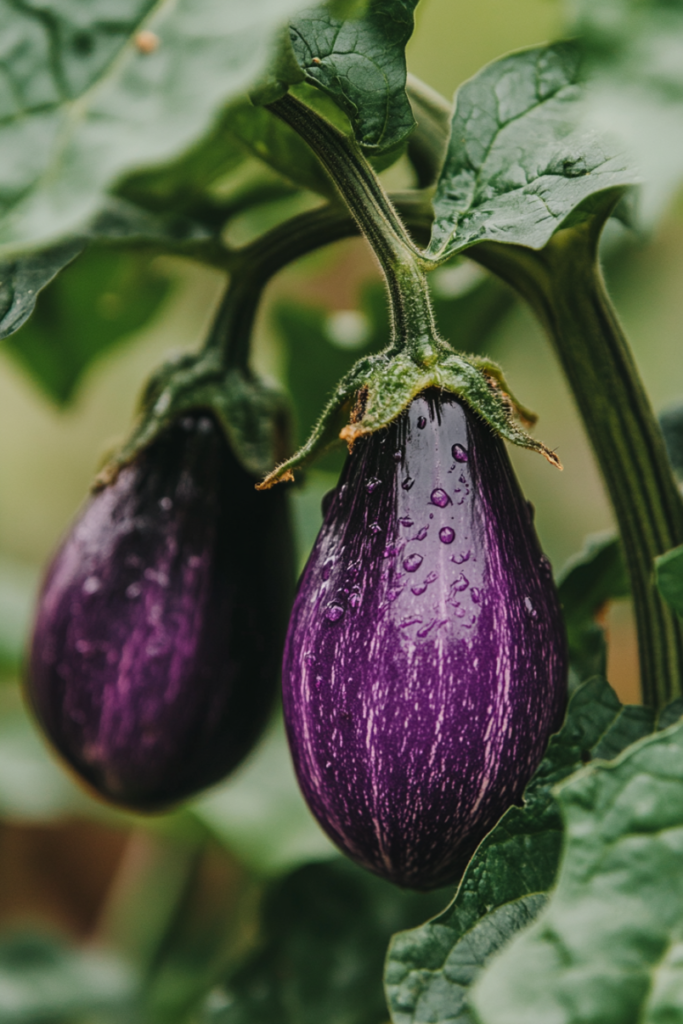
Tomato hornworms
Tomato hornworms are large, green caterpillars with a distinctive horn-like tail and can reach up to 4 inches in length.
They are known for chewing through leaves and fruits, which can cause serious damage if left unchecked.
To manage them, you can handpick the caterpillars, introduce parasitic wasps, or apply Bacillus thuringiensis (Bt) as a natural control method.
Colorado potato beetles
Colorado potato beetles are golden-colored adult beetles with 10 black stripes running vertically down their backs.
The larvae are smaller, darker, and lack stripes.
These pests can cause significant damage by defoliating plants, which can stunt growth and reduce fruit production.
To control them, you can hand-pick the beetles, vacuum the undersides of leaves, and apply neem oil.
Whiteflies
Whiteflies are tiny flying insects that suck sap from plants.
Their feeding can lead to yellowing leaves and weakened plants.
To manage whiteflies, consider using integrated pest management (IPM) strategies, including biological control methods.
Stink bugs
Stink bugs are shield-shaped insects, usually brown or green, and are infamous for the foul smell they release when disturbed.
They damage eggplant fruits by piercing the skin and injecting a digestive enzyme that makes the fruit discolored, tough, and unfit to eat.
These pests can also feed on leaves and stems, leading to stunted growth and lower yields.
To manage stink bugs, regularly check your plants, especially during the fruiting stage.
Remove weeds and plant debris around the garden and consider using row covers to protect young eggplants.
Encouraging natural predators like parasitic wasps can also help control stink bug populations.
Planting nectar-rich flowers nearby can attract these beneficial insects.
Cutworms
Cutworms are the larvae of night-flying moths and can do serious harm to eggplant plants.
They usually target young seedlings by cutting through the stems at or near the soil line, causing the plants to collapse.
The typical signs of cutworm damage include cut or severed stems close to the ground.
In older plants, cutworms can girdle the stems, leading to wilting.

Common Diseases
Eggplants are also susceptible to several diseases, many of which are caused by fungi, bacteria, or viruses.
Understanding these diseases and how to manage them is crucial for a healthy crop.
Verticillium wilt
Verticillium wilt is a fungal disease that lives in the soil and infects plants through their roots.
It starts by causing yellowing and wilting of the lower leaves, and the problem gradually spreads throughout the entire plant, which may eventually die.
To manage this disease, rotate your crops, avoid planting eggplants in areas where other solanaceous crops like tomatoes or potatoes have recently been grown, and promptly remove and destroy any infected plants.
Phytophthora blight
Phytophthora blight is a fungal disease that flourishes in wet, poorly drained soils.
It causes water-soaked lesions on stems, leaves, and fruits, which can become soft and start to rot.
To manage this disease, improve soil drainage, avoid watering from above, and use fungicides if needed.
Powdery mildew
Powdery mildew is a fungal disease that shows up as a white, powdery coating on leaves.
Infected leaves may curl, turn yellow, and fall off early. Severe cases can lower fruit yield and quality.
To manage it, make sure there’s good air circulation around your plants, avoid over-fertilizing with nitrogen, and apply sulfur-based fungicides.
Bacterial wilt
Bacterial wilt is a disease caused by bacteria that spread through contaminated soil or water.
It causes the plant to wilt suddenly, often beginning with the youngest leaves.
The plant can collapse and die within a few days.
To manage bacterial wilt, use disease-resistant varieties, practice crop rotation, and remove and destroy any infected plants.
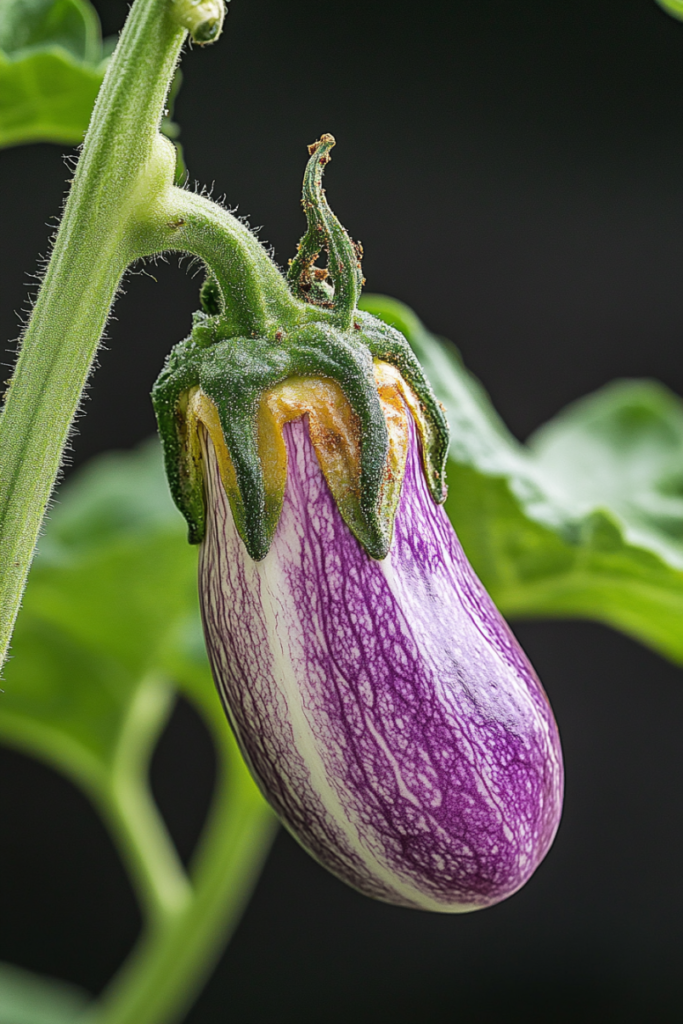
Cercospora leaf spot
Cercospora leaf spot is caused by the fungus Cercospora spp.
It shows up as circular spots on the leaves, usually with a yellow halo around them.
These spots can combine to create larger lesions.
To manage the disease, remove any infected leaves and apply fungicides such as chlorothalonil to help prevent it from spreading.
Damping off
Damping off is a disease caused by fungi like Pythium spp., Fusarium spp., and Rhizoctonia solani.
It affects young eggplant seedlings, leading to dark, water-soaked lesions at the base of the seedlings or on their leaves.
Infected seedlings often fall over.
To manage damping off, ensure good air circulation around seedlings, water from below whenever possible, and sterilize flats and pots before using them again.
Also, remove any affected seedlings to stop the disease from spreading.
Phomopsis blight
Phomopsis blight, caused by Phomopsis vexans, starts with pale, sunken spots on the fruit that quickly grow into soft, spongy areas extending into the flesh.
Leaves can also show gray or brown spots that are rounded or oval.
To manage the disease, immediately discard any infected fruits you find and use an organic fungicide to help prevent it from spreading to other fruits.
Colletotrichum fruit rot
Colletotrichum fruit rot, caused by Colletotrichum spp., begins with small, sunken, gooey spots on the fruit that can expand into larger blotches.
As the disease progresses, you’ll see concentric circles on the lesions and orange or pink, jelly-like patches of spores.
To prevent this issue, keep fruit off the soil and harvest before it gets too ripe.
Remove and discard any infected plants and use disease-free seeds for planting.
Blossom end rot
Blossom end rot is a physiological issue, not a disease, that commonly affects eggplant plants.
It appears as a dark, leathery spot on the bottom of the fruit.
This problem is often linked to calcium deficiency, irregular watering, and high temperatures.
Early blight
Early blight is caused by the fungus Alternaria solani.
It typically shows up as circular or oval dark brown spots with concentric rings on the leaves.
As the disease advances, these spots can merge, leading to large areas of dead leaf tissue.
Dark, sunken lesions may also appear on the stems. In severe cases, the fungus can infect the fruits, causing dark, leathery spots.
Early blight thrives in warm, humid conditions with poor air circulation.
Injured plants, whether from insects or mechanical damage, can be more susceptible as these wounds provide entry points for the fungus.
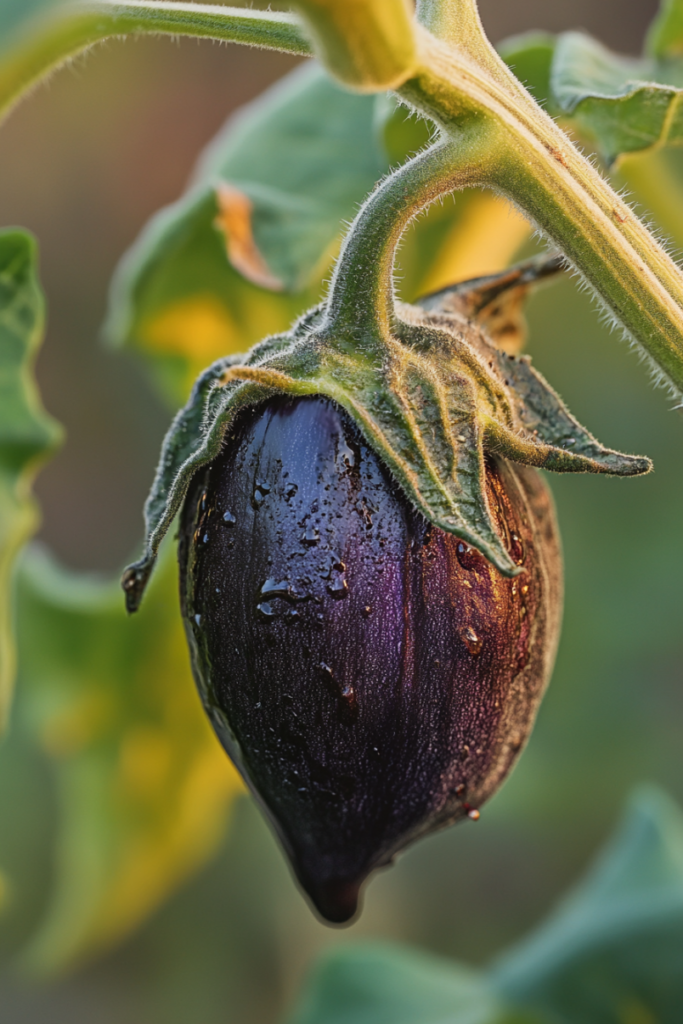
How to Prevent
To effectively prevent pests and diseases in eggplants, several integrated strategies can be employed.
Here are key practices to consider:
Crop management practices
- Rotate crops: Rotate eggplants with non-solanaceous crops (e.g., beans, melons, carrots) to reduce soilborne diseases and pests that can persist in the soil.
- Space plants properly: Space plants adequately (about 1 to 2 feet apart) to ensure good air circulation, which helps prevent fungal diseases and allows for easier access for pest management.
- Prepare the soil: Amend soil with organic matter like compost and ensure it is well-drained. This promotes healthy root systems and reduces the risk of root rot and other diseases.
- Controlling weed: Keep the garden free of weeds and debris that can harbor pests and diseases. Regularly remove any plant material at the end of the growing season.
- Practice proper watering: Water plants at the base to avoid wetting the foliage, which can promote fungal diseases. Ensure consistent moisture without overwatering, which can lead to problems like blossom end rot.
Pest management strategies
- Use physical barriers: Use row covers or collars around young plants to protect against early infestations of pests like flea beetles and aphids. Remove these covers once plants are established.
- Encourage biological control: Introduce natural predators (e.g., ladybugs) to help control aphid populations. This method can reduce reliance on chemical pesticides.
- Monitoring and early detection: Regularly inspect plants for signs of pests or diseases. Early detection allows for timely intervention, which can prevent larger outbreaks.
- Use of eco-friendly treatments: Apply organic fungicides or biopesticides, such as those containing Bacillus subtilis, to manage fungal and bacterial diseases without harming beneficial insects.
- Use healthy seedlings: Always start with disease-free seedlings and avoid planting in areas where previous crops have suffered from pests or diseases.
Disease prevention techniques
- Choose resistant varieties: Select eggplant varieties that are resistant to common diseases, which can significantly reduce the incidence of issues like wilt and blight.
- Keep sanitation: Clean tools and equipment regularly to prevent the spread of pathogens. Disinfect pots and flats before reuse to minimize disease transmission.
- Enhance soil health: Incorporate beneficial microorganisms into the soil to enhance its health and resilience against pathogens. This can include using EM (Effective Microorganisms) preparations.
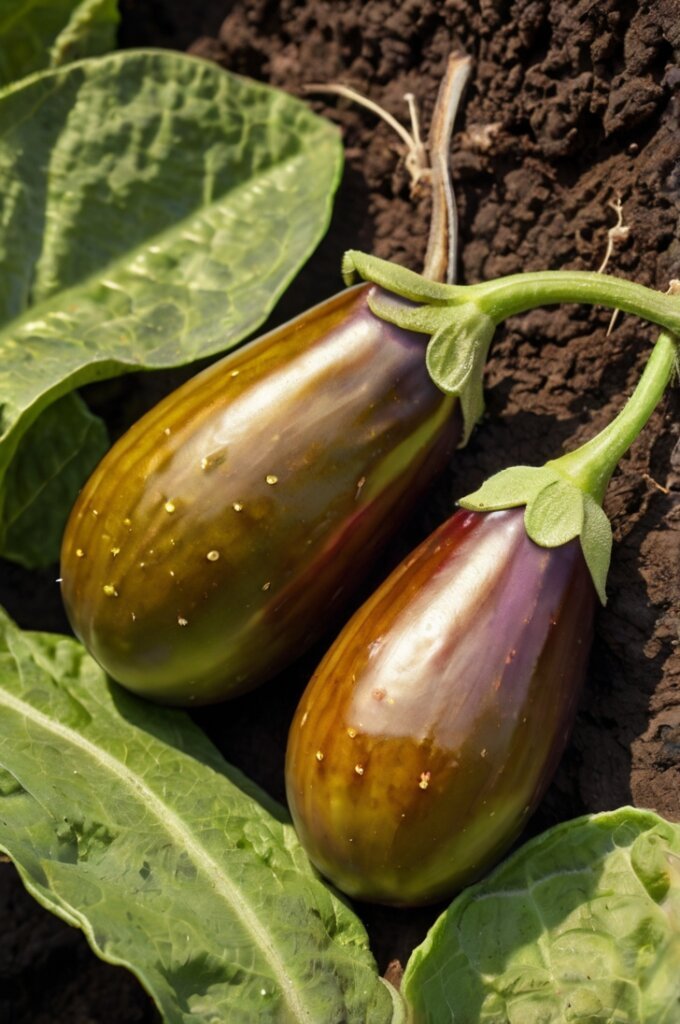
Conclusion
Growing eggplants can be a rewarding experience, but it comes with its challenges.
By understanding the common pests and diseases that affect eggplants and taking preventive measures, you can ensure a healthy, bountiful harvest.
Regular monitoring, good cultural practices, and timely interventions are key to keeping your eggplants thriving.
FAQs
While chemical pesticides are effective, it’s best to start with organic options like neem oil or insecticidal soap to minimize environmental impact.
Blossom end rot is a physiological disorder caused by calcium deficiency. To prevent it, ensure consistent watering, use balanced fertilizer, and avoid over-fertilization. Mulching can also help retain soil moisture and improve calcium uptake.



